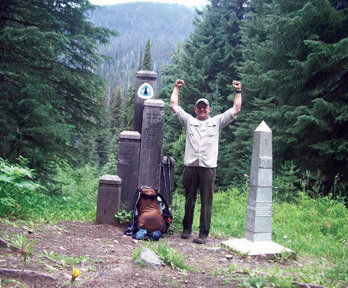
SBHS teacher completes eight-year hike from Mexico to Canada
While it is said that a journey of a thousand miles begins with
a single step, Jim Ostdick’s recently completed eight-year quest to
traverse the 2,650-mile-long Pacific Crest National Scenic Trail
featured many such steps.
The San Benito High School earth science teacher joined select
company this past summer by finishing the hike in segments from the
Mexican border to Canada over most of the past decade. He is one of
31 people listed on the Pacific Crest Trail Association’s Web site
as having completed the journey during 2009.
SBHS teacher completes eight-year hike from Mexico to Canada
While it is said that a journey of a thousand miles begins with a single step, Jim Ostdick’s recently completed eight-year quest to traverse the 2,650-mile-long Pacific Crest National Scenic Trail featured many such steps.
The San Benito High School earth science teacher joined select company this past summer by finishing the hike in segments from the Mexican border to Canada over most of the past decade. He is one of 31 people listed on the Pacific Crest Trail Association’s Web site as having completed the journey during 2009.
Starting on April 16, 2001 just south of the town Campo, at the southern terminus of the trail, Ostdick walked through three states, hiked in two dozen national forests and climbed countless mountain passes on his journey, which ended on July 23 of this year when he reached Manning Park in British Columbia.
Along the way, he gained a perspective on life and nature that he otherwise may not have known.
“The Pacific Crest Trail kind of gets in your blood,” said Ostdick, 58. “When you walk a little of it, you start wondering what it’s like over the next ridge; and the next; and the next.”
Though he can’t pinpoint exactly when or why he decided to take on the trail, Ostdick said he became acquainted with it during grad school when he visited mountain springs in the southern Sierra as part of his thesis on hydrogeology. He and a partner trained for a year to get ready for the first leg of the journey, which Ostdick wanted to make in 2001 because he was turning 50.
“I was … getting that panicky feeling like it’s now or never,” he said.
After the first 900 miles, in the middle of the Sierra Nevada, Ostdick’s partner decided she did not want to continue. Rather than being deterred, Ostdick said finishing the trail “became an obsession.”
He did not walk the trail in 2002 because of knee surgery, but every summer after that he spent as much time on the trail as he could – typically all of July and parts of June and August.
“Physically, it’s tough to start out a hike when the snow hasn’t melted yet,” he said. “It takes a couple of weeks to get your legs in trail shape, no matter how you train, and hiking in the snow can really beat you up.”
Though portions of the trail are not well-marked, Ostdick said the trail was easy to find when it wasn’t covered in snow. During those stretches, he relied on his map and compass skills and learned how to read saw cuts to find his way.
“You sort of develop a sense for it, too,” he said. “I never got so lost that I couldn’t get found again pretty soon. The hardest part of following the trail is in deep forest when there are deep snow drifts. Sometimes, you just have to grit your teeth and trust your compass.”
In the High Sierra, where Ostdick felt like he could “see forever,” he would pick out a pass and aim for it, despite the snowy path. He would also follow other hikers’ footprints “within reason.”
“You can read the tracks and usually see pretty well if the person ahead of you is making good decisions,” he said.
While the Sierra snow presented a challenge, the Southern California desert heat gave Ostdick a real scare.
“I became dangerously dehydrated coming down from the San Jacinto Mountains into the 110-degree desert near Palm Springs,” he said, noting that his hands, feet, arms and legs cramped at once, forcing him to sprawl in the shade of a granite boulder “and suffer until sundown.”
His partner was still with him at this point in the journey, and Ostdick credits her with saving his life by rigging a tarp for shade and pouring Gatorade and water into him until he could hold down the liquids.
“Lesson learned,” he said. “Don’t underestimate the desert.”
Ostdick didn’t have any dangerous run-ins with animals, though he shared his hike with rattlesnakes, bears, coyotes and “crabby mother grouse,” ground-nesting birds in the chicken family. A mountain lion sighting “put the fear of the Lord in me” a few years back near Quincy, but the cat bound up a steep embankment without giving Ostdick a second thought.
After the first 900 miles, Ostdick mostly walked alone. His brother joined him for a short walk near Lake Tahoe and a friend accompanied him for 85 miles near Lake Shasta.
“It was a fantastic experience,” he said of his solitary journey. “You hear all of that pop psychology Oprah stuff about learning to be your own best friend and all of that and you laugh, but I enjoyed my extended quiet time immensely. As teachers, we are intensely involved with the lives of others [but] a month on the trail erases all of that stress.”
An alter-ego that he created on the trail kept Ostdick focused and positive on the trek, which featured 20- to 30-mile hikes each day.
“This pal-of-mine self-reflection process of decision making served me well,” he said, leading to his PCT trail name “Palomino.” Many adventurers give themselves a trail name that they use on their journey.
Nights were spent on the ground in a tent or “sometimes out in the open, cowboy-style,” Ostdick said. He stayed as hidden from the trail and as far away from water sources as was practical, usually under a tree to protect from condensation.
He mailed boxes of food ahead of time to post offices and resorts along the way to help feed his appetite, “which becomes ravenous after a while, like a forest fire.”
“You just burn up everything you eat as fast as you can eat it,” Ostdick said. “So I learned to pack high-quality, nutritious meals to keep my energy up. I’d fill in around the edges with prodigious amounts of Snickers bars.”
To stay in touch with the outside world, Ostdick carried a lightweight, pocket e-mail composer from which he sent messages to family and friends “whenever I reached civilization; usually ever four or five days.”
His family was kept aware of his itinerary and with whom to get in contact if he didn’t touch base in a reasonable amount of time.
“Thankfully,” Ostdick said, “that was never an issue.”
Ostdick took photos throughout his journey and kept a journal to record his thoughts during or after his long hikes. He has shared parts of his journal with friends and family, but much of it he prefers to keep to himself.
“We baby boomers get so much flack for being self-absorbed and idealistic and the accounts of my trip are very much like that,” he said. “But I like to think there is a touch of universality in everybody’s experience of life, even if it’s something offbeat like a long-distance walk.”
The best parts of his journey from Mexico to Canada were the high Sierra passes along the John Muir Trail, Crater Lake and the Sisters Wilderness in Oregon, and the Pasayten Wilderness in Washington, Ostdick said.
The worst parts for him were the clear-cut forests of Northern California, fire-ravaged areas of central Oregon and “the god-awful 35-mile waterless stretches of scorched sand in the Mojave Desert.”
“But the very best?” he added. “I can’t describe the emotions I felt when I reached the northern terminus near Manning Park, British Columbia this past July 23. My heart is still full of joy from that day.”
Asked if he would have done anything differently, given the opportunity, Ostdick said he could have been more patient with his starting dates during the past few years – as that would have helped him avoid some snowy conditions.
“Part of me wishes that I had hiked the trail when I was younger, but part of me is glad that I waited,” he said. “At 58, I move a little slower than I did when I was 30, but I get just as excited about what I see – and maybe I see a little more now.”
In the classroom at San Benito High School, where Ostdick is also the advisor for the Outdoor Club, he frequently tells his students about his Pacific Crest Trail adventure.
“But I doubt that most of them really get the fun of it, much less the scale of it,” he said. “I know some of them do, though, and I tell them stories from time to time. I try to sell them on the importance of perseverance and the value of physical fitness and the power of nature.
“You never know for sure in our business whether or not you are making a difference in your students’ lives. They are in your room for a year and then they go away. You just make that leap of faith that some day they’ll find their path, too.”









